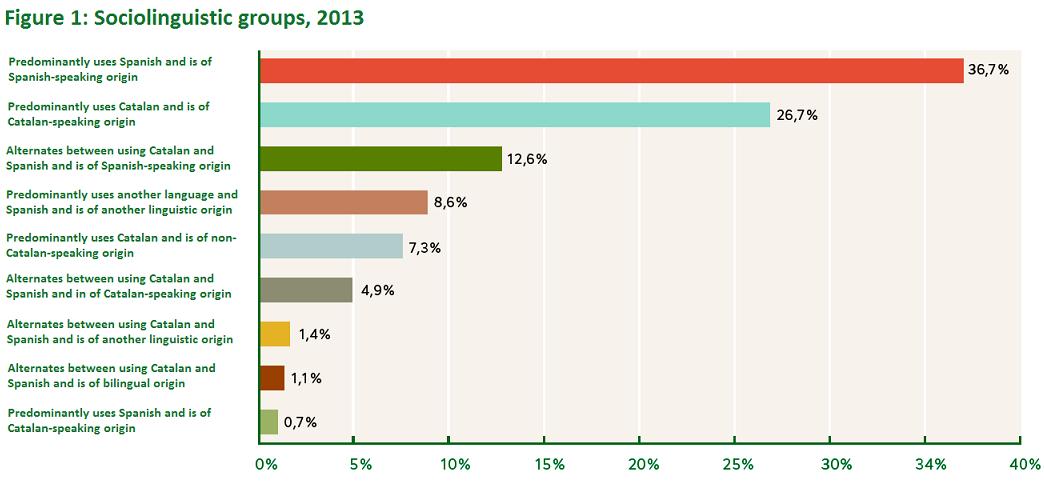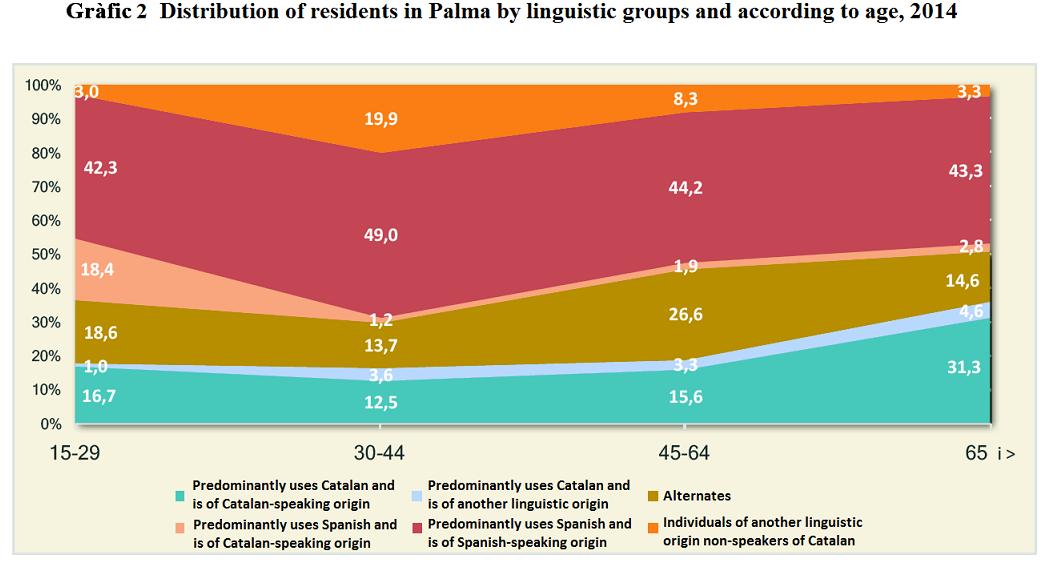25. Measuring sociolinguistic groups: The most significant transformations in Catalonia and the Balearic Islands
This post is also available in: Catalan
Natxo Sorolla
Universitat Rovira i Virgili, Xarxa CRUSCAT-Institut d’Estudis Catalans i
Centre de Recerca en Sociolingüística i Comunicació (CUSC) de la Universitat de Barcelona
Alongside Xavier Vila, I have been working for some time on sociolinguistic groups in Catalan language area. A single person’s linguistic usages may vary greatly from one area of life to another. An individual might speak in Catalan at home, in Catalan and in Spanish with friends in quite similar proportions, only in Spanish with the doctor, and only in Catalan with the person who serves him or her at the bank. The idea behind sociolinguistic groups is to create a usage index of spoken Catalan in 10 fields (IUP-10), which we believe is much more precise than more general propositions such as usual language or percentage of use in everyday interactions. The idea has certain parallels with studies on happiness, and above all, with what Daniel Kahneman, the only Nobel Prize-winning psychologist, suggests in relation to the polemics accompanying Easterlin’s studies on whether money can buy happiness (see the excellent episode on this from the Catalan TV show Economia en colors). These discussions centre on how to measure happiness, and how things differ if we ask about our state of happiness in general, as opposed to measuring happiness from moment to moment. To a certain degree, when we ask about happiness memories, we are more generous when it comes to our lives than we are when we have to note each moment of happiness, because even though we think that we are (in general) fairly happy, a good part of our day involves situations of stress, sadness or boredom. The idea that we strive for in sociolinguistics is to a certain extent that, beyond the memory that we have of our language usage, it is much more useful to measure and summarize what language we speak in specific areas or with specific interlocutors, such as the language used with friends, spouses, children and neighbours, or when in large commercial establishments, and so forth. The first way to measure happiness is certainly more related to what we would like to do than is the second way, which ought to be more realistic in terms of what we really do.
And so this index has been presented as very useful when summarizing information on language usage in a single variable, observing different sociolinguistic groups based on people’s family linguistic origin, and above all comparing different situations. We have started to work with the current methodology, which has allowed us to compare different waves and contexts, with data for Catalonia (Sorolla & Vila 2015). We first of all used the methodology to detect that a large part of the population predominantly uses its initial language, but there is a very significant non-Catalan-speaking population group that predominantly uses Catalan (7.3% of the population), which indicates the vitality of the language in the region (see the chart below). But at the same time, we have been able to detect that in the last decade there have been significant losses in the use of Catalan in Catalonia, concentrated mostly around the metropolitan area of Barcelona. These losses are not only caused by demographic issues such as the arrival of immigrants or the fact that the younger generation comprises fewer Catalan speakers, but also by sociolinguistic factors. And it is the latter that should raise greater concerns: members of the same generation with a shared social composition make less use of Catalan now than they did 10 years ago. For example, older Spanish-speaking generations seem to be using Catalan less than they were a decade ago, possibly due to changes in their everyday lives.
The second study that we have undertaken has been in the Balearic Islands (Vila & Sorolla 2017). It has just been published. The work that we undertook adopted the same technique, and it allowed us to observe that, once again, the most significant sociolinguistic groups are those in which linguistic use combines with family origin. But, unlike in Catalonia, the group of Catalan speakers from non-Catalan-speaking backgrounds is proportionally smaller (2.8%), and in contrast, its size is similar to the group which predominantly speaks Spanish but is of Catalan-speaking origin (2.5%), which is undergoing the opposite process. But in addition to not observing Catalonia’s vitality, we detected in Palma, Ibiza and Formentera that a lack of integration on the part of newcomers has unleashed a widespread process of Spanish use, even among some sectors of young Catalan speakers, through which they are abandoning use of their own language. See the chart below: a fifth of young people habitually use Spanish, despite being of Catalan-speaking origin.
Finally, and as a complement, we have reviewed the history of this process to create sociolinguistic groups. Xavier Vila began developing sociolinguistic groups through exploiting the Survey of Language Use for Catalonia 2003 (Vila 2005), and we continued the development with analysis for the Andorra 2004 (Sorolla, Bretxa &Vila 2006; Sorolla 2011), Franja 2004 (Sorolla 2014), and Catalonia 2008 (Sorolla & Vila 2011) surveys. But it was not until the 2013-15 wave of surveys that we consolidated the methodology by proposing that sociolinguistic groups should be defined theoretically, and not on the basis of empirical results, in order to be able to compare surveys conducted in different years or in different territories. Moreover, this approach has also been adapted to sociolinguistic surveys of Galician by Xaquín Loredo (Loredo 2015; Monteagudo, Loredo & Vázquez 2016).
References
Sorolla, N., & Vila i Moreno, F. X. (2015). Els grups d’ús lingüístic i els grans canvis en els usos entre el 2003 i el 2013. In Generalitat de Catalunya (Ed.), Anàlisi de l’Enquesta d’usos lingüístics de la població 2013. Resum dels factors clau. (Generalitat de Catalunya, Departament de Cultura, p. 30-33). Barcelona.
Vila, F. X., & Sorolla, N. (2017). La realitat i l’evolució a partir dels grups d’orígens i usos lingüístics. In J. Melià & M. del M. Vanrell (Ed.), Enquesta d’usos lingüístics a les Illes Balears. 2014 Anàlisi (Conselleria de Cultura, Participació i Esports (Govern de les Illes Balears) - Departament de Cultura (Generalitat de Catalunya) – Universitat de les Illes Balears, p. 106-124).
http://www.caib.es/govern/sac/fitxa.do?codi=3107481&coduo=2390443&lang=ca


